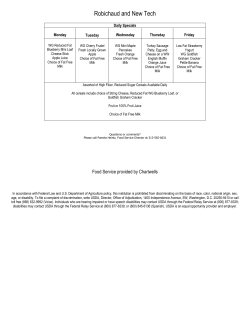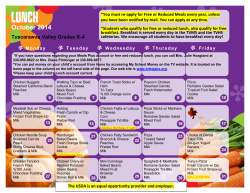
MPP-Dairy Dashboard: Evaluating Milk Prices Needed to Trigger MPP-Dairy
MPP-Dairy Dashboard: Evaluating Milk Prices Needed to Trigger MPP-Dairy John Newton Department of Agricultural and Consumer Economics University of Illinois Marin Bozic Department of Applied Economics University of Minnesota November 5, 2014 farmdoc daily (4):214 Recommended citation format: Newton, J., and M. Bozic. “MPP-Dairy Dashboard: Evaluating Milk Prices Needed to Trigger MPP-Dairy.” farmdoc daily (4):214, Department of Agricultural and Consumer Economics, University of Illinois at Urbana-Champaign, November 5, 2014. Permalink URL http://farmdocdaily.illinois.edu/2014/11/mpp-dairy-dashboard-evaluating-milk-prices.html Due in large part to expectations for a very large crop, U.S. average corn prices have declined sharply from their highs earlier in the year. The price declines in corn have helped to reduce livestock feed prices going into next year. If a period of lower and more stable grain prices persists then the risk to dairy farm income-over-feed-cost margins, and returns from the Margin Protection Program for Dairy Producers (MPP-Dairy), will arise from changes in the milk price driven by events specific to dairy markets. So a logical question to ask is: “How low do milk prices need to be to trigger MPP-Dairy payments?” Furthermore, since registering for any coverage level except the catastrophic level requires dairy producers to pay premiums it is important to understand how low milk prices would have to decline before program payments are greater than or equal to the premium rates. In today’s article we will answer both questions by introducing an interactive dashboard demonstrating what milk prices are needed to both trigger MPP-Dairy into payment status, and to recover paid premium costs, i.e., to break even, given a farm’s production history. Additionally, this new dashboard will help dairy producers and industry professionals translate MPP-Dairy margins into Class III milk prices which are used by a majority of the U.S. dairy industry as a benchmark pricing series. Equating MPP-Dairy to Class III milk prices will allow users to evaluate the equivalent milk price support provided by MPP-Dairy for any user-defined feed costs. A video explaining how to use the dashboard is available at We request all readers, electronic media and others follow our citation guidelines when re-posting articles from farmdoc daily. Guidelines are available here. The farmdoc daily website falls under University of Illinois copyright and intellectual property rights. For a detailed statement, please see the University of Illinois Copyright Information and Policies here. 1 farmdoc daily November 5, 2014 http://vimeo.com/110912499.The dashboard is fully interactive and functions on internet browsers supporting Adobe Flash and Shockwave players (see technical information at the end of the post). Dashboard users may: (i) adjust key feed input values for corn, soybean meal, and alfalfa hay; (ii) change the price series analyzed from Chicago Mercantile Exchange (CME) futures to USDA published prices; and (iii) change the coverage percentage. Then, by inserting the farm’s unique production history users may analyze what Class III milk prices or USDA all-milk prices are needed to both trigger MPP-Dairy payments and to recover premium costs during a consecutive two-month period. For side-by-side comparisons, additional dashboards may be opened in a separate browser window by clicking here. User-Selected Parameters Dashboard users may adjust several key variables (highlighted in orange) to illustrate program performance of MPP-Dairy: 1. Price Series – Users may select “USDA” or “CME”. When “CME” is selected the prices in the dashboard will reflect futures prices for corn, soybean meal, and Class III milk (no futures contracts exist for alfalfa hay). When “USDA” is selected the prices in the dashboard will reflect the USDA National Agricultural Statistics Service (NASS) published prices for U.S. average allmilk, corn, and alfalfa hay prices, and the USDA Agricultural Marketing Service (AMS) central Illinois soybean meal price. Depending on the option selected by the user, the MPP-Dairy trigger milk price and milk price needed to cover MPP-Dairy premiums will be displayed in either Class III or USDA all-milk prices. The “CME” price series is the default option and includes the average historical basis (cash minus futures price) of $1.53/hundredweight between the Class III milk price 2 farmdoc daily November 5, 2014 and the U.S. average all-milk price, and -15 cents per bushel between the CME corn price and USDA NASS corn price. 2. Production History (text box) - The production history is determined at sign-up in the first year of the program and is defined as the highest level of annual milk production during the 2011, 2012, or 2013 calendar years. Users can input the farm production history to evaluate how premiums and break-even MPP-Dairy milk prices are determined for different sized dairy operations. 3. Coverage Percentage (drop down menu) - Participating producers may receive MPP-Dairy coverage on 25% to 90% of their milk production history in 5% increments. Higher coverage percentages may increase premium rates and change the milk price needed to recover premium costs. Thus, by changing the coverage percentage the milk price needed to recover MPP-Dairy premiums is updated to account for the change in per hundredweight premium costs. 4. Feed Prices - The dashboard may accommodate CME prices or NASS/AMS published prices for corn and soybean meal. Alfalfa hay defaults to the NASS price as no futures for alfalfa hay exist. Depending on the price series selected the feed prices are adjusted to reflect basis. Currently a basis adjustment is made only for corn, where historically the published NASS price for corn has averaged $0.15/bushel below the CME futures price.1 Dashboard Output The dashboard includes several output metrics defined below: 1. MPP-Dairy Trigger Price – When the “CME” price series is selected, the MPP-Dairy trigger price represents an estimate of the consecutive two-month average Class III milk price needed for each MPP-Dairy coverage option to enter payment status given the user estimated feed values. When the “USDA” price series is selected, the MPP-Dairy trigger price represents the consecutive two-month average USDA all-milk price needed for each MPP-Dairy coverage option to enter payment status given the user estimated feed values. Since MPP-Dairy triggers on national, not farm-level, milk and feed prices the trigger price is independent of the farm’s production history and is the same for all participating operations. 2. MPP-Dairy Break-Even Milk Price – The break-even milk price depends on the premium rates for the farmer-selected coverage option. Premium rates for MPP-Dairy depend on the coverage level selected and the covered production history. Covered production history in excess of 4 million pounds is priced at a higher rate per hundredweight of milk. Additionally, for the 2014 and 2015 coverage years, all Tier 1 premiums except the $8 coverage option are discounted by 25%. Table 1 identifies the premium schedule for MPP-Dairy. As a result, the premium rates, and thus the MPP-Dairy break-even milk price will change based on the farmer-selected coverage options. When the “CME” price series is selected, the MPP-Dairy break-even price represents an estimate of the consecutive two-month average Class III milk price needed for each MPP-Dairy coverage option to cover the premium costs given the user estimated feed values. When the “USDA” price series is selected, the MPP-Dairy break-even price represents the consecutive two-month average USDA all-milk price needed for each MPP-Dairy coverage option to cover the premium costs given the user estimated feed values. Prices below the break-even prices may result in positive net returns from MPP-Dairy and help to smooth financial losses during poor margin years. 3. Ration Value – Based on the user’s feed price entries the dashboard uses the 2014 Farm Bill MPP-Dairy formula to determine the consecutive two-month ration value. The feed ration is given by: 1.0728 x NASS Corn Price ($/bu.) + 0.00735 x AMS Soybean Meal Price ($/ton) + 0.0137 x NASS Alfalfa Hay ($/ton). If applicable, the corn price is adjusted to reflect basis between the NASS and CME corn prices. 4. Premium Costs – Based on the amount of covered milk production (production history multiplied by the coverage percentage) the dashboard calculates the premium cost per hundredweight of covered milk production. The premium value is the amount the trigger milk price must decline in order for the MPP-Dairy coverage option to break even (holding feed prices fixed). 3 farmdoc daily November 5, 2014 Table 1. MPP-Dairy Premiums in Dollars per Hundredweight First Four Million Pounds Covered MPP-Dairy Coverage Level First 4 Million Pounds Covered (2014-2015) Coverage in Excess of 4 Million Pounds $4.00 No Cost (2016+) No Cost No Cost $4.50 $0.01 $0.01 $0.02 $5.00 $0.02 $0.03 $0.04 $5.50 $0.03 $0.04 $0.10 $6.00 $0.04 $0.06 $0.16 $6.50 $0.07 $0.09 $0.29 $7.00 $0.16 $0.22 $0.83 $7.50 $0.23 $0.30 $1.06 $8.00 $0.48 $0.48 $1.36 Summary The sign-up deadline for MPP-Dairy for the 2014 and 2015 coverage years is December 5, 2014. To assist in the farm program decision process we’ve introduced a new dashboard tool to help dairy producers consider how MPP-Dairy may work to protect against catastrophic financial losses in dairy production margins. A key feature of the dashboard it that it anchors to both Class III manufacturing milk prices and the USDA all-milk price to help to make a direct connection between MPP-Dairy coverage levels and milk prices. Given recent feed price declines and the anticipated size of the U.S. crop, the risk in dairy markets in nearby months is likely to be driven by potential declines in U.S. milk prices. Understanding how low milk prices need to fall for MPP-Dairy to enter payment status is a key risk management consideration. For example, given a $3.75/bu. corn futures price, $200/ton alfalfa hay price, and a $330/ton soybean meal futures price it is estimated that the consecutive two-month average Class III milk price would need to be $11.50 per hundredweight for the $4 catastrophic coverage to enter payment status. “How much protection is needed against falling milk prices?” and “Is the run of high feed prices over?” are key questions farmers should consider when evaluating MPP-Dairy coverage options. The dashboard helps farmers make informed risk management decisions by evaluating the financial implications for each of these questions. Notes 1 The dashboard does not include forecasts of market prices for milk or feed and is for demonstration purposes only. Basis patterns in milk and feed may change the MPP-Dairy break-even milk price. Technical Information on Adobe Flash and Shockwave Players For help with Adobe Flash Player see http://get.adobe.com/flashplayer/ For help with Adobe Shockwave see http://get.adobe.com/shockwave/ 4 farmdoc daily November 5, 2014
© Copyright 2025









